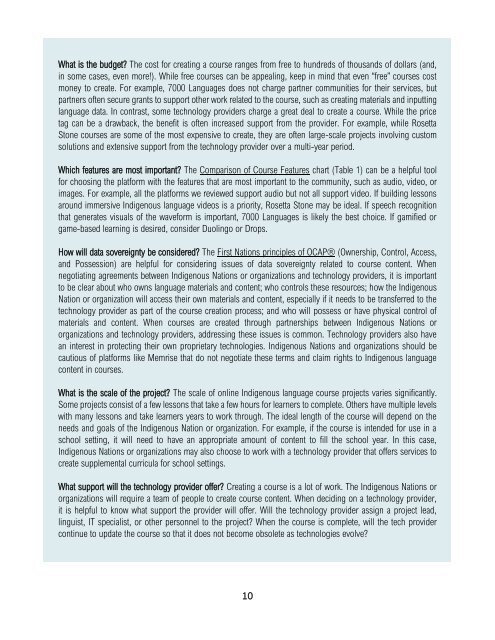Learning in Relation: A Guide to Creating Online Indigenous Language Courses that Center Indigenous Ways of Knowing and Being
by Kari A. B. Chew, Ph.D. (Editor & Author), Melvin Calls Him Jr. (Author), Jackie Dormer (Author), and Courtney Tennell (Author) The purpose of this guide is to share knowledge with Indigenous Nations and organizations, technology developers, and scholars who are working to center and respect Indigenous ways of knowing and being in online Indigenous language revitalization spaces, including Indigenous language courses. Citation Chew, K. A. B. (Ed.). (2022). Learning in relation: A guide to creating online Indigenous language courses that center Indigenous ways of knowing and being. http://hdl.handle.net/1828/14403
by Kari A. B. Chew, Ph.D. (Editor & Author), Melvin Calls Him Jr. (Author), Jackie Dormer (Author), and Courtney Tennell (Author)
The purpose of this guide is to share knowledge with Indigenous Nations and organizations, technology developers, and scholars who are working to center and respect Indigenous ways of knowing and being in online Indigenous language revitalization spaces, including Indigenous language courses.
Citation
Chew, K. A. B. (Ed.). (2022). Learning in relation: A guide to creating online Indigenous language courses that center Indigenous ways of knowing and being. http://hdl.handle.net/1828/14403
You also want an ePaper? Increase the reach of your titles
YUMPU automatically turns print PDFs into web optimized ePapers that Google loves.
What is the budget? The cost for creat<strong>in</strong>g a course ranges from free <strong>to</strong> hundreds <strong>of</strong> thous<strong>and</strong>s <strong>of</strong> dollars (<strong>and</strong>,<br />
<strong>in</strong> some cases, even more!). While free courses can be appeal<strong>in</strong>g, keep <strong>in</strong> m<strong>in</strong>d <strong>that</strong> even “free” courses cost<br />
money <strong>to</strong> create. For example, 7000 <strong>Language</strong>s does not charge partner communities for their services, but<br />
partners <strong>of</strong>ten secure grants <strong>to</strong> support other work related <strong>to</strong> the course, such as creat<strong>in</strong>g materials <strong>and</strong> <strong>in</strong>putt<strong>in</strong>g<br />
language data. In contrast, some technology providers charge a great deal <strong>to</strong> create a course. While the price<br />
tag can be a drawback, the benefit is <strong>of</strong>ten <strong>in</strong>creased support from the provider. For example, while Rosetta<br />
S<strong>to</strong>ne courses are some <strong>of</strong> the most expensive <strong>to</strong> create, they are <strong>of</strong>ten large-scale projects <strong>in</strong>volv<strong>in</strong>g cus<strong>to</strong>m<br />
solutions <strong>and</strong> extensive support from the technology provider over a multi-year period.<br />
Which features are most important? The Comparison <strong>of</strong> Course Features chart (Table 1) can be a helpful <strong>to</strong>ol<br />
for choos<strong>in</strong>g the platform with the features <strong>that</strong> are most important <strong>to</strong> the community, such as audio, video, or<br />
images. For example, all the platforms we reviewed support audio but not all support video. If build<strong>in</strong>g lessons<br />
around immersive <strong>Indigenous</strong> language videos is a priority, Rosetta S<strong>to</strong>ne may be ideal. If speech recognition<br />
<strong>that</strong> generates visuals <strong>of</strong> the waveform is important, 7000 <strong>Language</strong>s is likely the best choice. If gamified or<br />
game-based learn<strong>in</strong>g is desired, consider Duol<strong>in</strong>go or Drops.<br />
How will data sovereignty be considered? The First Nations pr<strong>in</strong>ciples <strong>of</strong> OCAP® (Ownership, Control, Access,<br />
<strong>and</strong> Possession) are helpful for consider<strong>in</strong>g issues <strong>of</strong> data sovereignty related <strong>to</strong> course content. When<br />
negotiat<strong>in</strong>g agreements between <strong>Indigenous</strong> Nations or organizations <strong>and</strong> technology providers, it is important<br />
<strong>to</strong> be clear about who owns language materials <strong>and</strong> content; who controls these resources; how the <strong>Indigenous</strong><br />
Nation or organization will access their own materials <strong>and</strong> content, especially if it needs <strong>to</strong> be transferred <strong>to</strong> the<br />
technology provider as part <strong>of</strong> the course creation process; <strong>and</strong> who will possess or have physical control <strong>of</strong><br />
materials <strong>and</strong> content. When courses are created through partnerships between <strong>Indigenous</strong> Nations or<br />
organizations <strong>and</strong> technology providers, address<strong>in</strong>g these issues is common. Technology providers also have<br />
an <strong>in</strong>terest <strong>in</strong> protect<strong>in</strong>g their own proprietary technologies. <strong>Indigenous</strong> Nations <strong>and</strong> organizations should be<br />
cautious <strong>of</strong> platforms like Memrise <strong>that</strong> do not negotiate these terms <strong>and</strong> claim rights <strong>to</strong> <strong>Indigenous</strong> language<br />
content <strong>in</strong> courses.<br />
What is the scale <strong>of</strong> the project? The scale <strong>of</strong> onl<strong>in</strong>e <strong>Indigenous</strong> language course projects varies significantly.<br />
Some projects consist <strong>of</strong> a few lessons <strong>that</strong> take a few hours for learners <strong>to</strong> complete. Others have multiple levels<br />
with many lessons <strong>and</strong> take learners years <strong>to</strong> work through. The ideal length <strong>of</strong> the course will depend on the<br />
needs <strong>and</strong> goals <strong>of</strong> the <strong>Indigenous</strong> Nation or organization. For example, if the course is <strong>in</strong>tended for use <strong>in</strong> a<br />
school sett<strong>in</strong>g, it will need <strong>to</strong> have an appropriate amount <strong>of</strong> content <strong>to</strong> fill the school year. In this case,<br />
<strong>Indigenous</strong> Nations or organizations may also choose <strong>to</strong> work with a technology provider <strong>that</strong> <strong>of</strong>fers services <strong>to</strong><br />
create supplemental curricula for school sett<strong>in</strong>gs.<br />
What support will the technology provider <strong>of</strong>fer? Creat<strong>in</strong>g a course is a lot <strong>of</strong> work. The <strong>Indigenous</strong> Nations or<br />
organizations will require a team <strong>of</strong> people <strong>to</strong> create course content. When decid<strong>in</strong>g on a technology provider,<br />
it is helpful <strong>to</strong> know what support the provider will <strong>of</strong>fer. Will the technology provider assign a project lead,<br />
l<strong>in</strong>guist, IT specialist, or other personnel <strong>to</strong> the project? When the course is complete, will the tech provider<br />
cont<strong>in</strong>ue <strong>to</strong> update the course so <strong>that</strong> it does not become obsolete as technologies evolve?<br />
10




